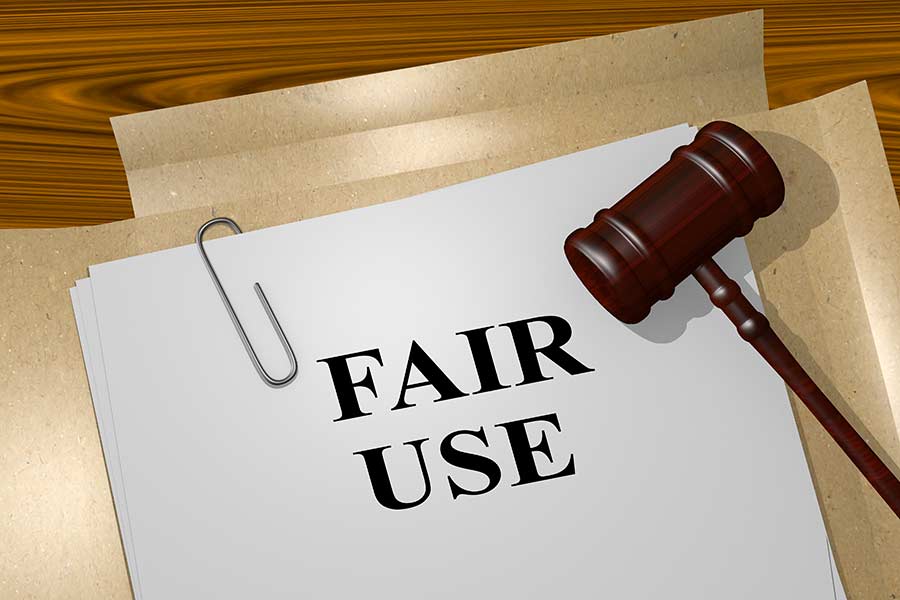What Every Copyright Holder Should Know About “Fair Use”
“Fair use” is a term that creative artists (and their lawyers) hear quite a bit. It is often used as a defense in copyright infringement litigation.
Understanding fair use and its potential ramifications should be important to anyone who makes a living creating original, copyrighted work.
Fair use is the doctrine that permits the limited use of copyrighted work without a license, permission, or compensation.
In other words, on occasion, your copyrighted videos, pictures, writing, or graphic designs can be used by others – legally – with no permission and free of charge. As long as the copyrighted work is being utilized consistently with fair use, there is no copyright infringement.
Evaluating Fair Use In Copyright Infringement Cases
Under Section 107 of the Copyright Act, “fair use of a copyrighted work…for purposes such as criticism, comment, news reporting, teaching (including multiple copies for classroom use), scholarship, or research, is not an infringement of copyright.”
Beyond the statement above, there is no strict definition of what is and what is not fair use.
However, the copyright act provides a framework for courts to determine if something falls under this doctrine. After evaluating all of the considerations, what is and is not fair use is decided on a case-by-case basis.
Section 107 of The Copyright Act Guides Fair Use Decisions
The court has four primary considerations when determining if secondary use of a work falls under the fair use doctrine and, therefore, is not infringing on a copyright. You can find them in Section 107 of the Copyright Act. https://www.copyright.gov/title17/92chap1.html#107
If you are a creative professional and file a lawsuit for copyright infringement, you should know what to expect if the other side claims they are protected by fair use. The court will consider the following factors in their decision:
The character and purpose of the use, including whether such use is of a commercial nature or is for nonprofit educational purposes –
The court will also look at whether the secondary user transformed the character of the work by doing more than just copying and using the original work exactly as it is. In other words, courts will determine whether the secondary user substantially altered the original work by changing its meaning or expression. Such examples may include a parody which ridicules the original work, or criticism directed at the merits of the original work. Secondary users may also quote from an original work, or take a screenshot of a video or photo, in order to comment on some public controversy surrounding the original work. Whether or not a work is deemed transformative is often a difficult question, but Sanders Law Group’s experience in these matters may help assist you with that determination.
The nature of the copyrighted work –
The greater the degree of uniqueness or creativity, the less likely the court might be to allow fair use. For example, a poised portrait in a controlled setting is often considered more creative than a candid shot taken in public.
The amount and substantiality of the portion used in relation to the copyrighted work as a whole –
Generally, the less used, the more likely the court will find fair use. But this is not a rule – quantity is just one factor for consideration. There have been several cases where the use of a small but important piece of a larger work was copyright infringement. On the other hand, some courts permit the secondary user to reproduce the entirety of an original work to make its point. Again, fair use is determined on a case-by-case basis.
The effect of the use upon the potential market for or value of the copyrighted work –
For example, courts have found that a parody of an original work does not compete with the market demand for the original work. But if the secondary user reproduces a work that essentially occupies the same market as the original, then potential market impact may be found. There is no magic formula for whether someone’s use of your copyrighted work is fair. These factors are all important to that determination and must receive consideration by the court. The courts can take into account other factors as well as appropriate.
Don’t Let Fair Use Prevent You From Pursuing Infringers
If you are a creative professional, don’t assume that something is fair use just because someone says it is. In copyright infringement cases, whether something is fair use depends on several factors, and the court will make its decision by analyzing each individual case. The lawyers at Sanders Law Group deal with infringers claiming fair use on a regular basis and are here to assist in defending against a claim of fair use.
Call Sanders Law Group to find out how we can help when someone uses your work without permission.
We want to ensure your interests are represented and our experience with copyright infringement lawsuits and fair use claims makes us uniquely suited to protect your rights and work.
Call us today at (800) 979-3707 to schedule your free case evaluation with our experienced copyright infringement lawyers.



